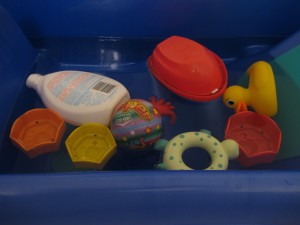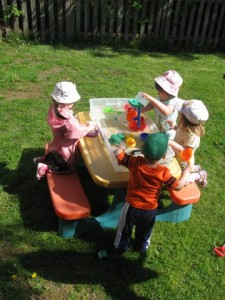This month kindergarten readiness plays-of-the-day are all about exploring and discovering, something that kids do from the time they are born. Scientists do the same thing, so in a way, children are natural scientists as they play and learn. Kids, from babies to kindergarteners, love to play with water. If the weather is warm enough, a big tub on the deck or on the lawn is lots of fun. If not, a chair pulled up the kitchen sink will work. Or use a big plastic bowl or storage container on the table or floor.
A few containers, spoons, and some water in the sink or tub will keep a child busy and engaged. Let your child experiment with filling and pouring. Small spoons will fill up a bowl slowly, big ones fill it up much quicker. This is learning about volume. Older kids often like to fill a cup to the very top and see how much more they can add before it runs over. Strainers and other containers with holes are great for observing how water comes right through the holes. While this seems obvious to us, kids will test it over and over, making sure the water does the same thing every time. Some objects will float on water and some will sink. Plastic spoons do not all float. What do wooden ones do? Old toothbrushes are fun to try. 
To extend the learning, you can ask your child to tell you what’s happening. Does the water stay in the cup when it’s turned over? What has more water, a big bottle or a little one? Does water in a square container pour like water in a round one? Does water feel kind of heavy? Children are learning to observe and also to predict what will happen. They make guesses and then check to see and ask questions too. These are all important skills not just for science but for all kinds of learning. Best of all, kids are directing their own play and learning in a way that is meaningful for them. One thing, water is easy to clean up. Is this an activity your child enjoys?
